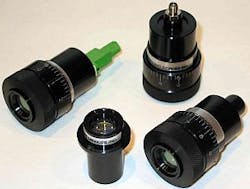Fiber collimating lens from DPM Photonics preserves output mode for 1.2 mm fibers
A multielement fiber collimating lens is specifically designed to prevent retroreflections near the input-fiber face. It preserves the output mode of fibers having core sizes up to 1.2 mm, while being equally suitable for collimating the lower numerical aperture outputs of large mode area (LMA) and photonic crystal (PC) fibers. Power handling is greater than 1 kW.
DPM Photonics
Vernon, CT
[email protected]
-----
PRESS RELEASE
DPM Photonics Introduces Precision High-Power Fiber Collimating Lenses
Vernon, CT (February 16, 2010) – DPM Photonics is now offering a multi-element fiber collimating lens that is specifically designed to prevent retro-reflections near the input-fiber face. The lens preserves the output mode of fibers having core sizes up to 1.2 mm, while being equally suitable for collimating the lower numerical aperture outputs of Large Mode Area (LMA) and Photonic Crystal (PC) fibers. Power handling is greater than 1 kilowatt.
“The combination of high power handling, absence of retro-reflections and output mode preservation from very large fiber cores makes this collimating lens an industry stand-out” said Dr. David Machewirth, President of DPM Photonics. “No other lenses on the market currently offer all these attributes”.
A wide range of operating wavelengths are available, including 532 nm, 800 nm – 1000 nm, 1064 nm, 1064nm/1550 nm and 1800 nm -2200 nm. This series of lenses accepts SMA and D-80 HPS (Mitsubishi)/LD-80 (Richard Losch, Inc.) fiber connectors. Both the operating wavelength and fiber connector can be modified upon request. A variable angle connector interface, for angled fibers, will soon be available.
“The wide operating range around 2 microns covers many different lasers, including Thullium and Holmium based devices”, continues Dr. Machewirth. “Erbium-Ytterbium laser users will appreciate the dual-wavelength A/R coatings available at 1064nm/1550nm as these systems are sensitive to reflections at both wavelengths. Those users collimating semiconductor laser outputs can utilize one lens for the range of laser lines available in the 800-1000 nm region”.
